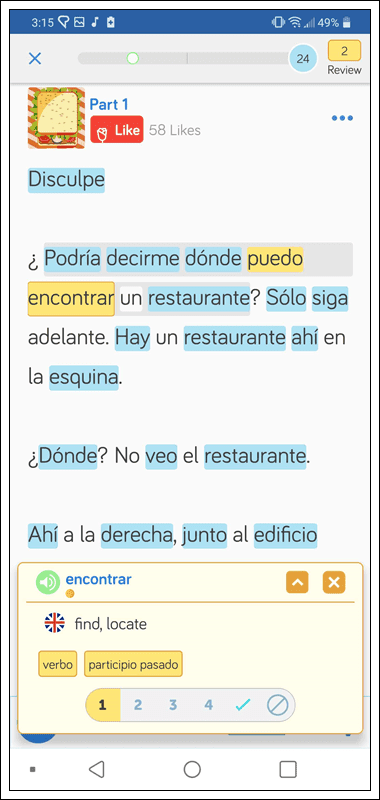Saying Happy New Year in Spanish
All around the Spanish-speaking world, New Years is a very big deal. People like to celebrate with loads of different songs, food, traditions and customs. So of course, you’ll also want to know how to say Happy New Year in Spanish.
Happy New Year in Spanish
Let’s start with the basic vocabulary you should know to be celebrating your New Years Eve in Spanish. The last evening of the year is called Nochevieja, which literally means ‘old night.’ This is the evening when everyone gets together to watch la cuenta regresiva (the countdown) happen a medianoche (at midnight).
So just to review our word bank…
Año Nuevo ‘New Year’
Nochevieja ‘New Years Eve’
Medianoche ‘midnight’
Cuenta Regresiva ‘countdown’

So the question remains: how do we say Happy New Year in Spanish? Well, when the clock finally strikes midnight, everyone yells…
¡Feliz Año Nuevo!
In the midst of the excitement and merry making, people often shorten the expression down to…
¡Feliz Año!
You can also use the expression ¡Próspero Año Nuevo! However, this sounds a bit more formal and stilted than the simple feliz año nuevo would. It’s used in the set expression…
¡Feliz Navidad y un Próspero Año Nuevo!
This means the same thing as ‘Merry Christmas and Happy New Year.’ You can see it on holiday cards and hear it in songs through the ‘hispanohablante’ (Spanish speaker) world. In fact, Jose Feliciano uses it in the famous Christmas song ‘Feliz Navidad.’
You might also hear someone say the set expression Te deseo un próspero año nuevo (I wish you a prosperous new year).
Some Spanish New Year’s Traditions
Every country and every community has its own tradition, but we thought we should mention a few that are common throughout the Spanish-speaking world. This should help you further your Spanish skills into the new year.
The 12 Grapes Tradition
If you’ve ever spent a lot of time around Spanish speakers, then you might already know the tradition of eating grapes on New Years.
Before the cuenta regresiva (countdown), the host of a New Years Party will give out a bowl to each guest with exactly twelve grapes. These are known as las doce uvas de la suerte (the grapes of good luck). These should be the first thing you eat in the new year. It’s such a tradition, you can buy packs of them in stores.
Why twelve, though? It’s simple really. Doces uvas – doce meses (twelve grapes – twelve months), so eating each one should bring prosperity and luck for each month. The tradition has its origins in Spain and goes back at least 100 years, but today it’s customary in many Latin American countries as well as Spanish speaking communities abroad.
Brindis (Toast)
People around the world like to clink glasses of champán (champagne) and make speeches. In Spanish, these are called brindis and one can hacer un brindis (make a toast) as well as brindar (to toast).
Hacemos un brindis por ella!
‘Let’s make a toast to her!’Brindemos por los nuevos comienzos!
‘Let’s toast to new beginnings!’
Take note of two things. Firstly, the word brindis is both the singular and the plural of the word. Secondly the words brindis and brandar use the preposition por to discuss the celebrated subject.
Los Fuegos Artificiales (The Fire Works)

Of course, New Year’s Eve just wouldn’t be right without some color in the sky. Spanish speakers take pride in their tradition of fireworks, so you should know the name for it. Thankfully, los fuegos artificiales (literally ‘the artificial fires’) is quite easy to remember. As in English, the term is almost always used in the plural.
Estoy esperando que empiecen los fuegos artificiales.
‘I’m waiting for the fireworks to start’
Resoluciones de Año Nuevo (New Year’s Resolutions)
Like so much of the world, people in Spanish-speaking countries like to set goals for the new year. In English, they’re called resolutions and in Spanish, people call them resoluciones. So, not very different and not hard to recall. You might also hear people call their new plans propósitos de Año Nuevo, but the idea is still the same.
Some of the ideas for the most common propósitos de Año Nuevo may look familiar.
Bajar de peso ‘lose weight’
Dejar de fumar ‘quit smoking’
Comer saludable ‘eat healthy’
Día de Año Nuevo (New Year’s Day)
The day after the party is also very important to people. The first of January (Día de Año Nuevo) is marked by different festivities, parades and parties. Often there will be a large family meal that day.
Learn Spanish Faster Using LingQ
Immersing yourself in Spanish doesn’t require you to travel abroad or sign up for an expensive language program.
However, it can be a bit tiresome to find interesting content, go back and forth between sites, use different dictionaries to look up words, and so on.
That’s why there’s LingQ, the fastest way to learn Spanish online! A language app that helps you discover and learn from content you love.

You can import videos, podcasts, and much more and turn them into interactive lessons.
Keep all your favourite Spanish content stored in one place, easily look up new words, save vocabulary, and review. Check out our guide to importing content into LingQ for more information.
LingQ is available for desktop as well as Android and iOS. Gain access to thousands of hours of audio and transcripts and begin your journey to fluency today.
***
John Melnyk is a freelance writer and translator from Florida, USA living in the Netherlands. He has a masters degree in Linguistics and Communication and is currently working on his first novel.

